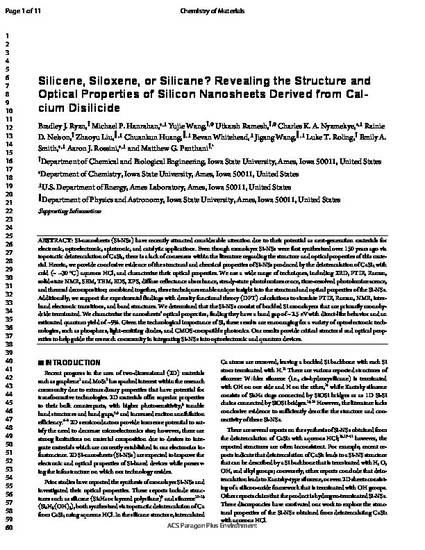
Si-nanosheets (Si-NSs) have recently attracted considerable attention due to their potential as next-generation materials for electronic, optoelectronic, spintronic, and catalytic applications. Even though monolayer Si-NSs were first synthesized over 150 years ago via topotactic deintercalation of CaSi2, there is a lack of consensus within the literature regarding the structure and optical properties of this material. Herein, we provide conclusive evidence of the structural and chemical properties of Si-NSs produced by the deintercalation of CaSi2 with cold (~ –30 °C) aqueous HCl, and characterize their optical properties. We use a wide range of techniques, including XRD, FTIR, Raman, solid-state NMR, SEM, TEM, EDS, XPS, diffuse reflectance absorbance, steady-state photoluminescence, time-resolved photoluminescence, and thermal decomposition; combined together, these techniques enable unique insight into the structural and optical properties of the Si-NSs. Additionally, we support the experimental findings with density functional theory (DFT) calculations to simulate FTIR, Raman, NMR, interband electronic transitions, and band structures. We determined that the Si-NSs consist of buckled Si monolayers that are primarily monohydride terminated. We characterize the nanosheets’ optical properties, finding they have a band gap of ~2.5 eV with direct-like behavior and an estimated quantum yield of ~9%. Given the technological importance of Si, these results are encouraging for a variety of optoelectronic technologies, such as phosphors, light-emitting diodes, and CMOS-compatible photonics. Our results provide critical structural and optical properties to help guide the research community in integrating Si-NSs into optoelectronic and quantum devices.
Available at: http://works.bepress.com/aaron-rossini/69/

This document is the unedited Author’s version of a Submitted Work that was subsequently accepted for publication in Chemistry of Materials, copyright © American Chemical Society after peer review. To access the final edited and published work see DOI: 10.1021/acs.chemmater.9b04180. Posted with permission.